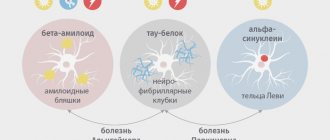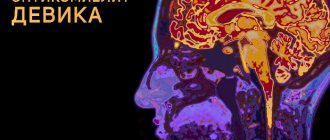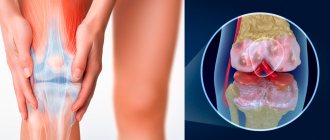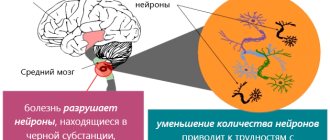What is Binswanger's disease
Binswanger's disease is a chronic, slowly progressive disease of the central nervous system, the pathogenesis of which is associated with the development of encephalopathy. The etiological factor is a prolonged increase in blood pressure (symptomatic hypertension).
The pathology manifests itself mainly in people over 50 years of age. The result of Binswanger's disease is severe neurological changes that lead to a person's helplessness, dependence on his immediate environment, and medical personnel.
Symptoms
The main signs of the initial stage of Binswanger encephalopathy include: fatigue, headache, loss of sleep, isolation.
As the disease progresses, the patient begins to develop speech disorders and problems with the swallowing reflex. It becomes difficult to control urination, especially at night. Binsvangrer's disease manifests itself in deterioration of coordination of movements, partial or complete loss of balance , and tremors of the limbs.
With further progression of the disease, dementia occurs, memory and attention decrease, and the person cannot perform the most primitive physical actions. Binswanger's disease is characterized by temporary periods of stabilization of the condition followed by intensification of the resulting lesions.
Patients with this diagnosis are characterized by the presence of memories and the inability to remember new life events. In rare cases, seizures of epilepsy may occur . In the future, the person suffers from frequent mood swings and loss of interest in life. Movement disorders, like dementia, develop gradually.
In the later stages, progressive leukoencephalopathy is characterized by a strong slowing of a person’s steps, loss of coordination when turning or complex movements. Such patients most often move in a wheelchair.
It is very important to carry out timely differential diagnosis, which will help to establish the true cause of the disease. This will allow you to select an effective treatment regimen and prevent further progression of the disease.
General symptoms and early signs of the disease
Symptoms of Binswanger's disease manifest themselves in gradual progression:
- mental disorders;
- movement;
- pelvic disorders.
Following this, mental retardation and inability to care for oneself develop. Signs of Binswanger's disease depend on the severity. Initially, a person develops a shuffling gait. He can move in small steps, with his feet practically never lifted from the floor. Subsequently, the automaticity of walking changes completely. At the same time, the person begins to control every step. His gait resembles walking on a slippery floor.
Another manifestation of the disease is “overactive” bladder, which is accompanied by the following symptoms:
- frequent urination;
- uncontrolled urination at night and incontinence during the day.
Motor disturbances are accompanied by mild hemiparesis. In the emotional sphere, a person manifests a depressive syndrome. The progress of pathology is combined with emotional impoverishment and loss of interest in previous hobbies.
Clinical manifestations
- The person loses cognitive function. Memory deteriorates, problems with speech begin, a person slowly begins to lose interest in everything that surrounds him. He is lost in society. Coordination of movements is impaired.
A magnetic gait appears, that is, a person moves in shuffling steps, afraid to lift his foot off the ground or floor. He stoops and moves slowly.
The disease causes more damage to the subcortical part of the brain, which contains the motor pathways of the brain.
- Overactive bladder. Urinary incontinence occurs frequently.
- Patients experience outbreaks of unreasonable aggression and irritability.
- Fatigue and insomnia appear.
- Pronounced signs of dementia develop.
Symptoms are more common in patients over fifty years of age. Elderly people have been and remain at risk. Those who have suffered from hypertension for a long time.
Etiology and pathogenesis of Binswanger's disease
The disease is preceded by arterial hypertension, which a person suffers from for a long time. Rarely, subcortical encephalopathy develops against the background of normal blood pressure or other changes.
In addition, predisposing factors include pathologies, which include:
- atherosclerosis;
- thromboembolism;
- metabolic disease;
- obesity;
- hypercholesterolemia;
- chronic heart disease.
Bad habits (smoking, alcohol abuse, fatty foods, passive lifestyle) are of no small importance.
Changes affect the white matter of the brain. First of all, sclerosis of small and medium-sized vessels develops, leading to a decrease in the lumen and thickening of the wall. Against this background, the blood supply to certain parts of the nervous system is disrupted, which leads to atrophy.
Numerous small hemorrhages occur, cystic formations and foci of destruction are formed. White matter density decreases. Hydrocephalus forms, the ventricles of the brain become wider.
Causes
In 95% of cases, Binswanger's disease is caused by long-term and malignant hypertension. The second common cause is amyloid arteriopathy, caused by genetic mutations. That is, the disease is partially inherited.
If a patient suffers from arterial hypertension, this does not mean that he will eventually develop atherosclerotic encephalopathy. This is facilitated by a sedentary lifestyle, the inclusion of alcohol and fats in the diet, diabetes mellitus, frequent psycho-emotional stress and obesity.
The development of Binswanger's disease depends on the course of arterial hypertension. The prognosis is less favorable when blood pressure fluctuates frequently, the circadian rhythm is disrupted (pressure does not decrease during sleep), the parents had hypertension and complications such as stroke or myocardial infarction.
The likelihood of Binswanger's disease increases if the patient suffers from CADASIL. It is a congenital arteriopathy characterized by episodic subcortical ischemic strokes, transient ischemic attacks and progressive leukoencephalopathy.
The pathological picture looks like this:
- Atherosclerosis – plaques on the walls of the cerebral arteries.
- Narrow lumen of blood vessels.
- Damage to the walls of small arterioles.
- White matter atrophy, most often in the lateral ventricles.
- Multiple foci of brain tissue necrosis.
- Demyelination of nerve fibers - the protein myelin, which ensures rapid conduction of nerve impulses, is destroyed.
- Increase in astrocyte volume.
- Multiple microinfarcts in the subcortical nuclei and white matter.
These disorders develop against the background of hypertension. Because of it, less blood flows to the brain. First, dyscirculatory encephalopathy occurs. Its manifestations are compensated by the adaptive capabilities of the brain. However, chronic ischemia in combination with provoking factors, such as stress, leads to acute circulatory disorders. Foci of necrosis and atrophy form in the brain due to the fact that the organ suffers from a lack of oxygen and nutrients.
Diagnosis of Binswanger's disease
Before making a diagnosis, the specialist conducts a comprehensive examination.
History and physical examination
First of all, the doctor collects an anamnesis. The clinical manifestations that the patient or his relatives will tell you about must be taken into account. Blood pressure is measured at the appointment. The results of previous measurements are taken into account.
Physical examination includes:
- assessment of appearance;
- gait feature;
- palpation, percussion, other characteristics of the heart;
- identification of speech disorders.
Instrumental research and laboratory diagnostics
Additional research methods will help clarify the disease, which include:
- CT scan;
- Magnetic resonance imaging;
- ECG;
- EEG.
The diagnosis is made based on the results obtained and the neuropsychological study performed.
Laboratory diagnostics include: general blood test, biochemical control of glucose, cholesterol and lipid profile, general urinalysis.
There must be several signs indicating pathology. These, in addition to hypertension, include:
- diabetes;
- myocardial infarction;
- suffered a stroke;
- walking disorders, etc.
In the process of differential diagnosis, Alzheimer's disease is first excluded.
A special ischemic scale helps to clarify the presence of a disease in the anamnesis, with the help of which the following is specified:
- suddenness of symptoms;
- severity of mental disorders;
- presence of depressive disorders;
- presence of neurological disorders, etc.
Comprehensive diagnostics
More often than not, it all starts with corresponding complaints from patients or their relatives.
The doctor compares the picture of the disease, which includes previous, diagnosed diseases and symptoms.
Based on these, diagnostic methods are prescribed:
- CT scan;
- Electrocardiogram;
- Magnetic resonance imaging, that is, MRI;
- X-ray studies.
MRI is one of the important procedures in diagnosing Binswanger's disease.
MRI allows you to:
- Scan the brain
- Identify disorders and foci of disease.
Magnetic resonance imaging helps to obtain a picture of the desired area of the body, the doctor receives a clear picture of the disease.
Magnetic resonance imaging is quite safe and does not use x-rays. And it can be done for children and women of childbearing age.
When examining the brain, the person being diagnosed is injected intravenously with a contrast agent that does not cause allergies. Before the procedure, you should not eat for 2 hours. Loose and comfortable clothing is best suited for diagnosis.
The procedure is magnetic; before the procedure, you must remove all metal objects from the body, such as chains, rings, earrings, hearing aids, and all mobile devices.
You cannot leave magnetic cards, including credit cards, for the procedure. This leads to the loss of all information on them.
MRI helps to accurately establish the diagnosis.
Treatment of Binswanger's disease
Activities related to the prescription of drugs are carried out taking into account:
- stages of the disease;
- severity of clinical symptoms of the underlying disease;
- manifestations of mental, intellectual, etc. disorders.
Treatment goals:
- prevent or delay progression;
- improve quality of life.
No surgical intervention is provided.
Drug treatment
Drug treatment is mainly symptomatic. It is aimed at restoring normal blood pressure and improving mental functions. It is possible to restore the emotional sphere with the help of medications belonging to the group of antidepressants.
It is important to prevent a significant decrease in pressure and maintain values within 120/80 mmHg. Art., since the decrease contributes to the aggravation of the existing violations. It is possible to improve cerebral circulation with the help of antiplatelet agents.
Symptomatic treatment
Non-drug treatment
Non-drug treatment involves following the following recommendations:
- diet – it makes sense to stick to a strict diet, which is especially important if you are overweight. Nutrition should be rational and contain fiber. It is necessary to avoid spicy, fried, fatty foods;
- It is recommended to give up smoking and alcohol. Bad habits aggravate the medical history;
- measure your blood pressure regularly. It is important to choose a device that is convenient to use. The measurement results should be recorded in a special diary;
- rest more, do as much physical exercise as possible, and do housework;
- stop drinking coffee and strong tea;
- In order to eliminate occlusion and improve local blood circulation, massage of the collar area and back can be performed as prescribed by a doctor.
To correct the main symptoms, medication and physiotherapeutic treatment on an outpatient basis is sufficient. With the progression of cognitive dysfunction and the inability to fully care for oneself, hospitalization in a hospital or nursing home will be required.
There must be an emotional connection on the part of family and friends. It is important to maintain communication and friendly relations. Care in the form of hygiene procedures will help compensate for the lack of self-care.
Treatment methods
Treatment of Binswanger's disease is carried out comprehensively. First of all, therapy is aimed at eliminating the main causes of the disease - arterial hypertension, atherosclerosis. To effectively treat pathology, medications are prescribed:
- Vasodilators.
- Regulating the tone of the vascular wall.
- Improving cerebral blood circulation.
- Stimulating metabolic processes in neuronal tissues.
- Eliminating signs of depression.
- Stimulating cognitive functions.
- Regulating the function of urination.
- Antiepileptic, anticonvulsant.
Considering the advanced age of most patients, therapy for somatic diseases is carried out in parallel. It is necessary to create comfortable living conditions that exclude mental and physical fatigue.
Prognosis and life expectancy in the elderly with Binswanger disease
The disease gradually and constantly progresses. Different patients have different rates of progression. Unfortunately, many manifestations are irreversible. Timely treatment will help to more or less improve the quality of life. It is necessary to evaluate how adequate, independent, and able to work a person is. Based on this, decide whether it is possible to leave him at home, do any work, etc.
Over time, it makes sense to completely secure the area where a person is located. Create conditions that make life easier. Life expectancy and the presence of injuries largely depend on situations involving danger due to memory impairment.
From the onset of the disease until death, a person can live on average 5-8 years, which depends on many factors, for example, hereditary predisposition and chronic diseases.
Treatment of Binswanger syndrome
Unfortunately, the atrophic processes (demyelination) that have already occurred in the patient’s brain are irreversible, and therefore it is completely impossible to cure Binswanger’s disease. However, properly selected treatment can eliminate the main cause of vascular ischemia and relieve severe symptoms. Thus, the disease can go into remission with periods of exacerbations occurring more or less frequently. It is very important that treatment is prescribed individually, taking into account all concomitant diagnoses of the patient, his age, state of health at a particular time and other factors. Otherwise, the patient may face the most unfavorable outcome. The main methods used are medications and diet therapy. During the period of remission, sessions of ergotherapy and psychotherapy can be carried out with the patient.
To improve blood circulation in the cerebral vessels, selective blockers and antiplatelet drugs are prescribed. To maintain and improve cognitive functions - nootropics, membrane stabilizers, MAO inhibitors. But the main goal of pharmacotherapy is to reduce blood pressure, therefore, first of all, patients are prescribed blood pressure stabilizers. It is important that medications do not cause hypotension, as this can worsen the course of the disease.
With the right therapy, 60% of patients experience improvements after just a two-week course of treatment.
How to improve the quality of life in patients
To improve your quality of life, first of all, you must follow your doctor’s prescription. Clinical recommendations include the use of vascular medications as well as medications that reduce symptoms of dementia. It is necessary to keep under control the underlying disease against which Binswanger's disease developed. It is important to stabilize blood pressure, and most importantly, to avoid jumps from low to high values.
An elderly person must adhere to a nutritious diet and lead an active lifestyle. It is recommended to take regular walks in the fresh air, not to limit yourself in communication and intellectual activities (read books, memorize poems, solve crosswords).
It is possible to track the progression of the disease over time through regular preventive examinations. It should be carried out by a general practitioner and a neurologist several times a year. In addition to examination, additional research methods are indicated: blood test, urine test, CT scan.
Diagnostic methods
The initial appointment is carried out by a neurologist who examines the patient and listens to the main complaints. Among the methods for studying Binswanger's disease are:
- computer and magnetic resonance imaging of the brain, which help to accurately identify pathologies in the subcortical region, circulatory disorders, etc.;
- ECG is used to diagnose concomitant cardiac pathologies (in patients with atherosclerotic stenosis, stroke, heart attack, etc.);
- Radiography allows us to identify superficial disorders of the structure of the brain.
It is very important to conduct differential studies that can distinguish Binswanger's disease from Alzheimer's disease. They have similar symptoms, so doctors often make an erroneous diagnosis. The treatment of these two pathologies differs, so it is necessary to obtain reliable diagnostic results.










